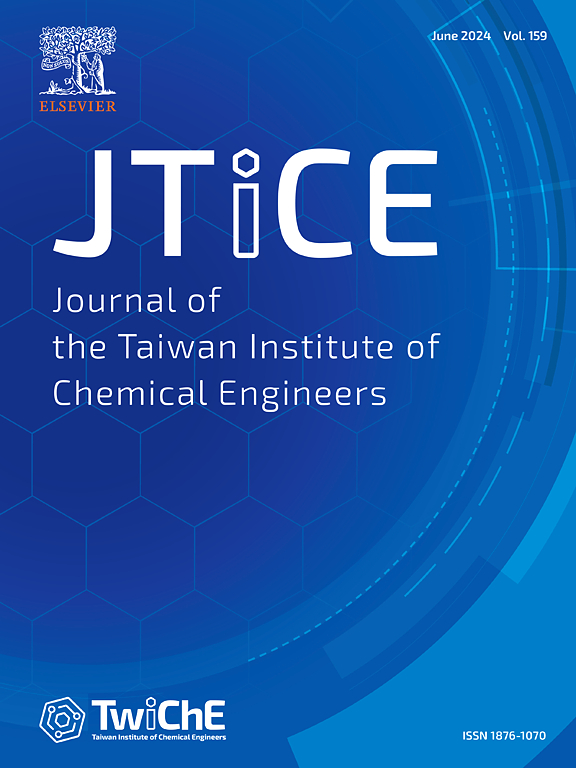Ultrahighly permeable carbon molecular sieving membranes enabled by blocking the precursor polyimide molecules with 6FAP moieties
IF 5.5
3区 工程技术
Q1 ENGINEERING, CHEMICAL
Journal of the Taiwan Institute of Chemical Engineers
Pub Date : 2025-03-19
DOI:10.1016/j.jtice.2025.106096
引用次数: 0
Abstract
Background
Selecting appropriate polymer precursors is essential for developing high-performance carbon molecular sieve membranes (CMSMs) for gas separation, as precursor structure significantly impacts the resulting membrane's thermal stability, microstructure, and gas transport properties.
Methods
This study reports the synthesis of a novel polyimide for CMSMs fabrication, which features a main chain backbone of tetrahydrocyclobuta (1,2-c:3,4-c') difuran-1,3,4,6-tetraone-1,4-bis (4-amino-2-trifluoromethylphenoxy) benzene (CBDA-6FAPB), with 2, 2-bis (3-amino-4-hydroxyphenyl) hexafluoropropane (6FAP) diamine as a block monomer via ternary co-polymerization. The thermal stability, surface functional groups, microstructure and morphology of the membranes were characterized by thermogravimetric analysis (TGA), Fourier-transform infrared spectroscopy (FTIR), X-ray diffraction (XRD) and scanning electron microscope (SEM), respectively. The effects of varying 6FAP proportions, and the permeation conditions on the thermal stability of polyimide, the microstructure and gas separation performance of CMSMs were systematically investigated.
Significant findings
Results show that increasing the proportion of 6FAP enhances the selectivity of CMSMs, with the gas permeability initially rising then decreasing. Exceptionally ultrahigh permeabilities are achieved, corresponding to 7690.0 Barrer (H2), 2578.6 Barrer (CO2) and 1466.5 Barrer (O2), along with the selectivities of 31.0 (H2/N2), 10.4 (CO2/N2) and 5.9 (O2/N2), for CMSMs made by the proportion of 5% of 6FAP segments. In summary, the as-prepared CMSMs are excellent and promising with attractively commercial prospect.

通过用6FAP基团阻断前体聚酰亚胺分子,实现了超高渗透性的碳分子筛膜
选择合适的聚合物前驱体对于开发用于气体分离的高性能碳分子筛膜(CMSMs)至关重要,因为前驱体结构对所得膜的热稳定性、微观结构和气体输运性能有重要影响。方法采用三元共聚合法制备了以四氢环丁基(1,2-c:3,4-c′)二呋喃-1,3,4,6-四酮-1,4-二(4-氨基-2-三氟甲基苯氧基)苯(CBDA-6FAPB)为主链主链,以2,2 -二(3-氨基-4-羟基苯基)六氟丙烷(6FAP)二胺为嵌段单体的新型聚酰亚胺。采用热重分析(TGA)、傅里叶红外光谱(FTIR)、x射线衍射(XRD)和扫描电镜(SEM)对膜的热稳定性、表面官能团、微观结构和形貌进行了表征。研究了不同6FAP配比、不同渗透条件对聚酰亚胺热稳定性、CMSMs的微观结构和气体分离性能的影响。结果表明,增加6FAP的比例可提高CMSMs的选择性,其透气性先升高后降低。对于6FAP段比例为5%的cmms,其渗透率分别为7690.0 Barrer (H2)、2578.6 Barrer (CO2)和1466.5 Barrer (O2),选择性分别为31.0 (H2/N2)、10.4 (CO2/N2)和5.9 (O2/N2)。综上所述,制备的CMSMs性能优良,具有良好的商业前景。
本文章由计算机程序翻译,如有差异,请以英文原文为准。
求助全文
约1分钟内获得全文
求助全文
来源期刊
CiteScore
9.10
自引率
14.00%
发文量
362
审稿时长
35 days
期刊介绍:
Journal of the Taiwan Institute of Chemical Engineers (formerly known as Journal of the Chinese Institute of Chemical Engineers) publishes original works, from fundamental principles to practical applications, in the broad field of chemical engineering with special focus on three aspects: Chemical and Biomolecular Science and Technology, Energy and Environmental Science and Technology, and Materials Science and Technology. Authors should choose for their manuscript an appropriate aspect section and a few related classifications when submitting to the journal online.

 求助内容:
求助内容: 应助结果提醒方式:
应助结果提醒方式:


